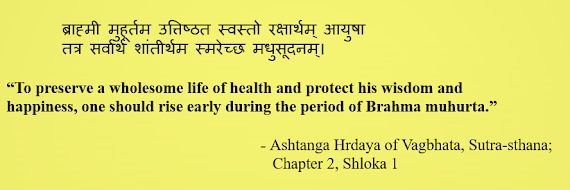Brahma Muhurta
Brahma Muhurta
The period from 4 a.m. to 6 a.m. is sacred to Brahmins. To all who are acquainted with Ayurveda, these are the hours of Vata, when lightness of being is present when the soul can most easily be accessed by our heavy, thick material minds. Brahma muhurta is literally translated in Sanskrit as the moments (muhurta ) of Brahma, the energy of the creator, as the day is created consciously in the moments just before dawn.
Ideally, we should rise between 4 a.m. and 6 a.m., depending on the latitude and time zone in which we live. We should spend 1–2 hours with ourselves before the world demands our time. Sages knew this. Farmers knew this. They knew they needed to maximize the time in their fields during the light of day. They used this predawn time to get their bodies and minds ready so that the remainder of the day could be spent outside. Ayurveda teaches that these morning hours have a lightness of being. They should be spent in that space between mind and body, where our spirit attunes us most easily to our life purpose. It is the most fresh and pure time of day, and provides the cleanest oxygen for exercise and for connecting with the purest part of our selves. Those who want to ride the wave of lightness, clarity and subtle energies may meditate or go for a euphoric morning run. Follow your instinct and watch your body’s reaction; adjust according to how it worked for you. This self-adjustment through trial and error and observation is called upasaya , advised by Ayurveda as one of the best ways of tailoring what you need for your body. To sum up👇
According to generations of ancient wise men, who were a combination of astrophysicist, geologist and expert biologist, the day is composed of thirty periods of 48 minutes each, called muhurtas. Brahma muhurta is two periods before dawn, in the span during twilight. If sunrise occurs at 6 a.m., Brahma muhurta at that location on that day is from 4.24 a.m. to 5.12 a.m., changing daily. The wise men used this time to expand their knowledge, as it symbolized light in all its meanings: illumination, wisdom, heat and buoyancy. It is the last part of the night, before the sun rises to proclaim a new day. The environment is also cleanest, containing the least pollutants, since people and animals sleep, as trees accelerate their production of clean oxygen using the white, pre-bright light of the sun. Noise and calls are absent from the predawn pleasant atmosphere of lightness, clarity and subtle energies. This span of 96 minutes before dawn until 48 minutes before dawn is like prime time for sacred transmissions between the gods and our bodies. There are many sacred ways to split the day into sections, such as the prahara system of eight blocks of 3 hours. Prahara s are reference periods indicating when particular activities should take place. The first prahara begins at sunrise and is for rising and meditation. The second prahara is for starting the day, setting up the home and preparing morning food. Eating during this second prahara is ideal for keeping digestive and immune systems healthy. The penultimate prahāra from midnight to 3 a.m. is the time for sleep. The last prahāra is the time just before dawn, for ending sleep, lovemaking and rising. This ashtam prahara , or eighth and last prahāra of the daily cycle, extends from 3 a.m. to 6 a.m. and is used to guide musicians about which compositions are optimal at this time for maximum alignment with nature and the body. Sometimes, these three-hour blocks are also called yama . (Note that this term is different from yama , which means restraints in yoga shastra.) Like prahara , yamas denote times of the day correlated with the power and angle of the sun, and optimal activities during these periods. To sum up👇





